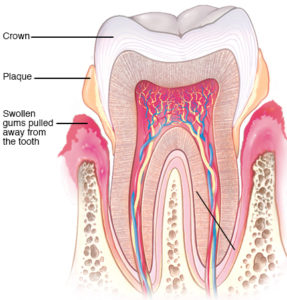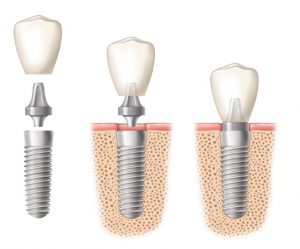Header logo
header top contact widget
dental specialist
Are YOU One Who Is More Likely To Have Gum Disease?
Posted on Dec 10, 2020 by William J. Claiborne, DDS MS
As a periodontist, I have a pretty unique view of the inside of a mouth.
In my specialty, we are particularly focused on the condition of the gum tissues in the mouth, or “periodontal” tissues. We are specially trained to treat all stages of gum disease and in the diagnosis and placement of dental implants.
A periodontal specialist is also trained in performing esthetic procedures that involve gum tissues, such as crown lengthening and correcting a “gummy smile”.
To clarify, a periodontist is a dentist who extends his or her education and skills further (typically 3 years past completing dental school) to specialize in the prevention, diagnosis, and treatment of periodontal disease and other gum conditions.
1). THE NATURAL AGING PROCESS
Although we treat patients of all ages, there are certain segments of the population we see more often. For instance, a large segment of our patients are age 50 and older. In addition to having more susceptibility to have gum disease, many in this age group have lost teeth.
In a recent report by the Centers for Disease Control & Prevention (CDC) on data related to prevalence of periodontitis in the U.S.: over 47% of adults ages 30 years and older have some form of periodontal disease. For adults 65 years and older, that number rises to over 70%.
This is because the aging process causes the body begins to succumb to wear and tear. The skin sags, bones weaken, joints ache, hearing dulls, and eyesight wanes. This means that more precautions and measures are needed to keep the teeth and gum tissues in good shape.
In addition to healthy gums, it’s important to keep your natural teeth as you age. Natural teeth to support neighboring teeth and provide stimulation to the jaw bone is unsurpassed.
Having the ability to comfortably and efficiently bite and chew is vital to having a healthy body. When dentures or partials compromise the ability to eat a diet of healthy foods – and chew food properly – gastrointestinal problems are common.
Although dental implants are excellent replacements for missing teeth, there is nothing as perfect as your “permanent” teeth.
There are a number of reasons why seniors face more oral challenges, including:
• A dry mouth: The tissues inside the mouth need to be kept moist. Saliva is designed to do this. However, with age, the flow of saliva becomes less plentiful. Just as the skin and hair get drier with age, the mouth undergoes this as well. When saliva flow is less efficient at rinsing bacteria from the oral cavity, bacteria grow at a more rapid rate. This allows bacteria accumulation to occur more frequently than twice-a-day brushing can control.
• Reduced ability to maintain at-home oral hygiene: Aging causes the fingers to be less nimble and stiffens joints. This is a particular challenge when it comes to brushing and flossing. Angling a toothbrush to reach all areas in the mouth and proper flossing maneuvers require manual dexterity that are more difficult due to the natural aging process.
• Medication side effects: The average American adult in the 65-79 age group has over 27 prescriptions filled each year. (https://www.statista.com/statistics/315476/prescriptions-in-us-per-capita-by-age-group/). Although you may need these medications, keep in mind that some can be detrimental to your oral health. This is why it’s important to provide a complete list of all medications you take (including vitamins and herbal supplements) at every dental appointment so your dentist can adjust care to your specific needs.
• Hormonal changes: Due to declining estrogen levels, post menopausal females have a higher risk for gum disease and subsequent tooth loss. This causes an increased risk of bone loss or osteoporosis as well as inflamed gum tissues around the teeth (called periodontitis). When there is a decline in jaw bone mass, it can result in tooth loss.
Bacteria overgrowth in the mouth is the cause of gum disease. Periodontal disease is the nation’s leading cause of adult tooth loss. Its bacteria can also enter the bloodstream, causing inflammatory reactions far beyond the mouth.
Advanced gum disease bacteria has been linked to a number of serious health problems. These include heart disease, stroke, high blood pressure, diabetes, arthritis, memory loss, some cancers, impotency and Alzheimer’s disease.
Obviously, maintaining healthy gums and keeping your natural teeth is important. If you’ve experienced tooth loss, we can replace them with dental implants. These are the closest thing to the natural teeth you had and will restore stability and dependable biting and chewing.
At any age, the goal is to keep bacteria levels in the mouth to the lowest level possible. When oral bacteria are allowed to accumulate, it can lead to Gingivitis. This is an early stage of gum disease. As it progresses, periodontal disease continually worsens. Eventually, it becomes periodontitis, which is an advanced level of gum disease.
Although gum disease can exist without obvious signs or symptoms, the most commonly noticed are:
• Red, swollen or tender gums
• Seeing blood in the sink when brushing
• Receded gums • Loose or separating teeth
• Pus pockets on gum tissues
• Sores in the mouth
• Persistent bad breath
2). ADULTS WITH DENTAL FEAR
Another large segment of our patients are those who have avoided dental care for years, often due to having dental fear.
One study, published by StudyFinds.org, shares recent findings of 2,000 adults in the U.S. regarding dental visits. Results show a whopping 62% of those surveyed stating they were too afraid to even visit a dentist’s office. (https://www.studyfinds.org/adults-too-scared-visit-dentist-teeth/)
If dental fears or anxiety have kept you from regular dental checkups for a year or more, it would be rare to NOT have some level of gum disease. Quite frankly, some people with high fear levels avoid seeing a dentist for decades. Those visits are vital in one’s ability to have healthy gums.
While twice daily brushing and daily flossing are necessary components for having good oral health, the routine alone isn’t enough to combat a number of additional factors that make one vulnerable to the disease.
For example, a study by Delta Dental revealed, only 7 out of 10 adults are brushing twice a day. This means that 30% aren’t brushing enough. (https://www.ada.org/en/publications/ada-news/2014-archive/october/survey-finds-shortcomings-in-oral-health-habits)
3). PREGNANCY
We also see a number of moms-to-be. For decades, the Surgeon General has warned that pregnant females who had gum disease had a far greater risk of a pre-term, low birth weight baby. Research has shown that gum disease increases the risk for pre-term delivery (prior to 37 weeks) and low birth weight babies (less than 5.5 lbs.).
“Studies have found that expectant mothers with periodontal disease are up to seven times more likely to deliver premature, low birth weight babies.” (https://www.adha.org/resources-docs/7228_Oral_Health_Total.pdf) One study showed the preterm birth rate for pregnant women with moderate to severe periodontal disease to be nearly 29%.
Estimates are that over half of pregnant women have some form of gingivitis (gum inflammation, an early stage of gum disease) or periodontitis (infectious, advanced gum disease). Nearly a third of pregnant females will acquire gum disease because of their higher vulnerability to inflammation.
When these indications exist, it is important to seek periodontal treatment as soon as possible. Gum disease only worsens without treatment, requiring more time and expense to rid this serious, even deadly, inflammatory disease.
4). ALL ADULTS
Regardless of age or health status, oral wellness has always been important to overall health. Without good gum health, there is a greater drain on the body’s immune system. This is now even more important than ever, due to COVID and the flu season upon us.
Remember, even a twice-daily brusher and daily flosser does not mean you will avoid gum disease. Avoiding regular dental check-ups is a sure recipe for needing treatment down the road that may have easily been prevented.
In our Asheville periodontal dental office, patients can begin with a consult in our private consultation room that’s removed from the clinical side of the practice. We are always happy to discuss oral health options with new patients. A referral is not needed.
Call 828-274-9440 to schedule.
If Your Mouth Is Frequently Dry, You Have Higher Risk For Gum Disease
Posted on Dec 02, 2020 by William J. Claiborne, DDS MS
Our bodies are home to trillions of micro-organisms. This includes micro ‘ponds’ of viruses, fungi, and bacteria. As we’ve learned over the years, some of this bacteria is highly beneficial to how our systems operate.
Although the thoughts of bacteria often conjure up images of infectious organisms, the mouth is home to some very “good” bacteria. For bacteria that are present under normal circumstances, they do not cause disease and actually have a purpose. It’s the “bad” bacteria I want to focus on for now.
Oral bacteria is the source of nearly every problem that develops in the mouth. The oral cavity (mouth) is structured to manage a certain level of bacteria. As the entry point of most of the bacteria we add to our bodies, it can process a “normal” amount on a day-to-day basis. It is the overload of bacteria that becomes the origination source of problems.
The reason people are advised to brush at least twice a day and floss daily is to remove accumulated oral bacteria from the mouth. When not removed on a regular basis, a sticky film of bacteria form that coats the teeth and gums. This film is known as plaque. Without sufficient and frequent removal of plaque, it begins to harden at the base of teeth.
This is tartar (or calculus), which is actually a cement-hard mass of oral bacteria. Tartar cannot be brushed or flossed away; it requires removal by a dental professional. During your dental cleanings, you probably notice when your hygienist is scraping away at teeth. It is tartar that she is trying to remove.
Your periodic dental cleanings are important. If tartar is allowed to further amass, the bacteria can become inflamed, attacking gum tissues. As bacteria continue to reproduce, they create an inflammation that extends beneath the gum line. The infection they trigger can reach down into the structures that support natural teeth, including tooth roots, tissues, ligaments and bone.
Periodontal disease is the leading cause of adult tooth loss. The advanced stage of gum disease, known as periodontitis, creates a bacteria so potent that research has linked it to serious diseases elsewhere in the body. These include some cancers, heart disease, stroke, Alzheimer’s disease, diabetes, arthritis, preterm babies, and impotency.
Saliva is the mouth’s natural rinse that helps cleanse oral bacteria from the mouth. This keeps bacteria levels to a minimum and lowers their ability to cause problems. When saliva flow is depleted, however, bacteria remain in the mouth longer – and multiply rapidly.
Saliva helps to continually cleanse your mouth, removing particles that can rot and cause bad odors. A condition called “dry mouth” (known as Xerostomia) is when production of saliva is decreased.
When the “dry mouth” condition is continual, the problem may be due to low salivary gland production or some diseases. Dry mouth naturally occurs during sleep and in people who breathe through their mouth. However, as a periodontal specialist, I find that most cases are due to factors that can be easily controlled with simple changes.
To support saliva flow and reduce “bad” bacteria in the mouth, twice daily brushing and flossing help. However, knowing contributors to a dry mouth can help you better manage or control oral bacteria levels. These include:
The aging process – Aging causes the skin, cartilage, and tissues to become less supple, drier. We can’t stop the aging process but can help protect our oral health by drinking plenty of water throughout the day. Coffee, tea and colas don’t count. Also, consider using an oral rinse designed to replenish moisture in the mouth.
Medications – Many over-the-counter and prescribed medications today have a side effect of oral dryness. Some of the worst culprits are antihistamines, depression and incontinence medications, and some that control blood pressure. If you take one of these, ask your doctor about options that may be less drying to the mouth. Or, increase your water intake and use a daily rinse to replenish oral moisture.
Sleep habits – To dry something out, a flow of air is just the thing. This also applies to the mouth. Snoring or breathing through the mouth during sleep create added dryness to oral tissues. Talk to your doctor about ways to resolve these problems. It may be as easy as adjusting your sleeping position or adding a side pillow.
Medical conditions – Having acid reflux, sinus infections, diabetes and bronchitis can cause dry mouth. A bad cold can also force people to breathe more through their mouth. For these conditions, be especially committed to your oral hygiene routine at home (brushing and flossing) and up your water intake.
Caffeinated beverages – Caffeine has a drying effect on oral tissues and therefore depletes the helpful rinsing benefits of saliva. Most colas contain caffeine, which is drying to oral tissues. Add to that the high acidity level in colas (also harmful to tooth enamel). Also drying are coffee and tea. Like colas, these drinks contain acid added to caffeine. If you drink these beverages, be sure to rinse your mouth after or alternate with gulps of water.
Alcohol (including beer and wine) – Mixed drinks, wine and beer are all drying to oral tissues. Add the acidity and sugar levels that exist in wine or mixers and these drinks pack a double-whammy to oral tissues. Again, swish with water between drinks or have a glass of water nearby to dilute the impact of these.
Smoking (cigarettes, cigars, vaping) – People who have smoked for years often have dry skin that ages their appearance far beyond their actual years. The same is occurring inside the mouth. Cigarette and cigar smoke is laden with toxic chemicals, which is true for e-cigs as well. Just be aware at your added risk and the drying effects and take added measures to keep your mouth clean and moist.
If you have delayed or avoided dental care, call 828-274-9440 to request a consultation, or begin with a thorough examination in our Asheville periodontal office. We offer the latest techniques, technology, and skills while always making patient comfort a top priority.
How To Avoid Gum Disease & Cavities From Sugar This Holiday
Posted on Nov 12, 2020 by William J. Claiborne, DDS MS
Regardless of size and distancing limitations on 2020 holiday gatherings, you can bet that Americans will still consume the yummy indulgences associated with the season. After all, we all need comfort food these days. The holidays simply give us “justification” for eating the sugary, rich treats we’ve waited all year to enjoy. We release the guilt and know we’ll pay for it through our new year’s resolutions.
I’m the last person on earth who would preach abstinence when it comes to things like thick egg nog, sugar cookies and pecan pie. Like you, I wait all year to savor things like this. However, I’m also a periodontist and have a unique look at what this added sugar can do to teeth and gums.
Keep in mind that all food (as well as beverages other than plain water) cause an acidic surge into the mouth. This is sent in via saliva and is the first stage of the digestive process. This acid is so strong it can actually soften tooth enamel for 20-30 minutes, leaving you with a higher risk for tooth decay.
Sugar also super-charges oral bacteria, which are living, eating and breeding organisms. They thrive in colonies as they subsist on gum tissues. As bacteria levels grow, the gums become inflamed. This is the first stage of periodontal (gum) disease.
As gum disease worsens, the inflammation caused by these bacteria can lead to persistent bad breath, receded gums that expose sensitive tooth roots, and gums that darken in color. If untreated, pus pockets can eventually form at the base of some teeth and attack the tooth supporting structures beneath the gums.
Eventually, teeth will loosen and can require removal. Also known as periodontal disease, this is the nation’s leading cause of adult tooth loss.
Even without the holidays, Americans are the biggest sugar consumers on earth. Although the World Health Organization (WHO) recommends no more than 5% of daily sugar intake, or less than 25 grams, Americans consume 82 grams each day, on average. That translates into over 19 teaspoons of sugar per day and 66 pounds each year, per person.
When researchers from the University College London & London School of Hygiene studied public health records from around the world, they found that 92% of American adults have cavities. Compare this to Nigeria, a country with a diet very low in sugar, where only 2% of the population have had tooth decay. Also concerning were their findings that nearly 90% of America’s school age children have experienced tooth decay.
Childhood obesity is also out of control. The Centers For Disease Control & Prevention (CDC) reports that the U.S. percentage of children with obesity “has more than tripled since the 1970s. Today, about one in five school-aged children (ages 6–19) has obesity.” That’s nearly one-third of children who are overweight or obese. https://www.cdc.gov/healthyschools/obesity/facts.htm Obesity is when fat content of the body is over thirty percent of its overall mass.
According to the Centers For Disease Control & Prevention (CDC), adults in the U.S. who are categorized as obese is at nearly 40 percent. Another 30 percent are categorized at overweight.
While sugar is not the only culprit, Americans have been lured into a lifestyle surrounded by sugary snacks and beverages. (After all, ads tell us that we need to grab a Snickers bar, not an apple, as an afternoon pick-me-up.)
You may be surprised to know that studies show that sugar is even addictive. It activates the same regions in the brain that react to cocaine. (https://www.brainmdhealth.com/blog/what-do-sugar-and-cocaine-have-in-common/)
How does this apply to your smile? Research has shown that obese adults have a 6 times higher potential to develop periodontal (gum) disease. As a periodontal specialist, my goal is always to help patients achieve optimal oral health. In our Asheville periodontal dental office, we address the risks of periodontal disease with our patients without judgement of their weight, but rather how we can help them enjoy a healthier smile.
As difficult as losing weight can be, it is important to be aware of risk factors that can make you more susceptible to gum disease. Initial symptoms include gums that are tender, swollen, and may bleed when brushing. This stage, known as gingivitis, is actually reversible with prompt, thorough oral hygiene.
This holiday, try to reduce your intake of sugar and carbohydrates. This will help to lower your potential for damage by oral bacteria, reducing your risk for cavities and gum disease. Additionally, be committed to a thorough at-home routine of daily flossing, twice a day brushing and drinking plenty of water.
If you are experiencing symptoms of gum disease, however, it is important to be seen by a periodontist as soon as possible to halt further progression. A periodontist is a dental specialist who has advanced training in treating all stages of gum disease as well as in the placement of dental implants. The earlier the treatment, the less involved treatment requirements will be. Gum disease will not improve without professional care.
Call 828-274-9440 to schedule an initial examination or begin with a consultation.
Understanding Dental Implants & Their Benefits
Posted on Nov 03, 2020 by William J. Claiborne, DDS MS
When you lose a natural tooth, even one that isn’t visible when you smile, its absence causes a reaction that takes place below the gum line. Many people are unaware of what occurs – at first. When it becomes obvious, it leads to problems that are not only bothersome, they are detrimental to your overall health.
The absence of a tooth root in the upper or lower jaw bone is a loss of stimulation the bone mass where it was once positioned. These roots provide stimulation and nourishment that enables the bone to maintain a healthy mass. Without the presence of tooth roots, the bone begins to “melt away.” The term for this process is known as resorption.
Resorption begins shortly after the tooth root is removed. Once it begins, it continues at an ever-increasing pace. For example, the first year after a tooth root is missing, the loss of bone may be minimal. With each passing year, the rate of loss accelerates.
As the bone shrinks in height, the natural tooth roots adjacent to the area of missing teeth are vulnerable to movement and root damage. On average, the teeth most likely to be lost are the ones next to areas of tooth loss.
For the support of remaining natural teeth, it’s important to replace missing teeth as soon as possible so adjacent teeth can retain their proper positions. It is even more important to replace missing teeth before bone loss begins. And, it’s HOW you replace them that’s most important.
Because dental implants replace the tooth above the gum line AND the root portion below it, the bone is able to retain its mass. Dental implants are designed to restore the look, feel and chewing stability like that of natural teeth.
As the advantages of dental implants become more familiar for natural tooth replacement, there are still some misconceptions among the general population. The following will hopefully clear up some of the confusion.
First, Dental Implants are a term that describes 3 components. The “implanted” portion is placed in your jaw bone where a tooth root was once held. The “implant” is not what holds the tooth. It serves to anchor an attached tooth (or bridge of two or more teeth).
Made from titanium, this metal bonds to living bone successfully. As a matter of fact, dental implants have one of the highest success rates of any implant-in-bone procedures.
The implanted portion becomes anchored in the jaw bone through a process known as ‘osseo-integration.’ Once the implant has been secured by the bone, a post is inserted into the center of the implant. This post is known as an abutment.
The replacement tooth (or teeth) is usually made of porcelain. This is the portion that you see and looks just like a natural tooth. This is known as a restoration or crown. It is attached securely to this post.
 Porcelain is commonly used to create the restorations because they provide the most durable material possible and have the look and feel of a natural tooth. Porcelain has a luminosity of natural teeth and even reflects light as a natural tooth would. Porcelain is also very resistant to staining.
Porcelain is commonly used to create the restorations because they provide the most durable material possible and have the look and feel of a natural tooth. Porcelain has a luminosity of natural teeth and even reflects light as a natural tooth would. Porcelain is also very resistant to staining.
When missing more than one tooth in one area, an implant is not always necessary to replace each one. As mentioned prior, one implant can often hold two or a bridge of teeth. Several strategically-placed implants may also be used support a full arch of teeth.
When people can chew properly and eat a healthy diet, their overall health is better. And, without the fear of embarrassing slips or clicks (often associated with denture wear), being socially active can continue to be a positive part of a happy life.
Dental implants restore the ability to eat with stability, chew comfortably, laugh and speak with confidence. Dental implants do not decay and will never need root canals. And, with proper care, they’ll last your lifetime.
There are many types of implants, each designed to accommodate specific needs. Many dental implants are chosen and placed by a Periodontist. This is a dental specialist who has extensive and specialized training in the diagnosis and placement of all types of dental implants. He or she can select the one that will work best for you.
Proper placement and support in caring for implants is an important part of a successful outcome. Dental Implants CAN fail. This is why a periodontal specialist can be an asset to your investment.
If infection sets in and reaches the implanted portion, the implant may need to be removed so treatment can resolve the problem. Your periodontist can assess gum health prior to placement and monitor your healing process to help minimize this risk.
There are other threats to dental implant success. Clenching or grinding teeth can also contribute to implant failure. Smoking complicates and delays the healing process and is also a known contributor to implant failure. Again, a periodontist can oversee your care to optimize your ability to enjoy a lifetime of confident smiles.
Call 828-274-9440 to arrange a consultation. During this time, we can discuss treatment that can achieve your needs and goals as well as the process and anticipated costs. If dental fear is a concern, I’ll also explain sedation options. We offer both oral sedation and IV sedation, if a “twilight sleep” state is preferred. Here, you’ll find your comfort is always a priority.
Recent Posts
Categories
Archives
- September 2024
- August 2024
- July 2024
- June 2024
- May 2024
- April 2024
- March 2024
- February 2024
- January 2024
- December 2023
- November 2023
- October 2023
- September 2023
- August 2023
- July 2023
- June 2023
- May 2023
- April 2023
- March 2023
- February 2023
- January 2023
- December 2022
- November 2022
- October 2022
- September 2022
- August 2022
- July 2022
- June 2022
- May 2022
- April 2022
- March 2022
- February 2022
- January 2022
- December 2021
- November 2021
- October 2021
- September 2021
- August 2021
- July 2021
- June 2021
- May 2021
- April 2021
- March 2021
- February 2021
- January 2021
- December 2020
- November 2020
- October 2020
- September 2020
- August 2020
- July 2020
- June 2020
- May 2020
- April 2020
- March 2020
- February 2020
- January 2020
- December 2019
- November 2019
- October 2019
- September 2019
- August 2019
- July 2019
- June 2019
- May 2019
- April 2019
- March 2019
- February 2019
- January 2019
- December 2018
- November 2018
- October 2018
- September 2018
- August 2018
- July 2018
- June 2018
- May 2018
- April 2018
- March 2018
- February 2018
- January 2018
- December 2017
- November 2017
- October 2017
- September 2017
- August 2017
- July 2017
- June 2017
- May 2017
- April 2017
- March 2017
- February 2017
- January 2017
- December 2016
- November 2016
- October 2016
- September 2016
- August 2016
- July 2016
- June 2016
- May 2016
- April 2016
- March 2016
- February 2016
- January 2016
- December 2015
- November 2015
- October 2015
- September 2015
- August 2015
- July 2015
- June 2015
- May 2015
- April 2015
- March 2015
- February 2015
- January 2015
- December 2014
- November 2014
- October 2014
- September 2014
- August 2014
- July 2014
- June 2014
- May 2014
- April 2014
- March 2014
- February 2014
- January 2014
- December 2013
- November 2013
- October 2013
- September 2013
- August 2013
- July 2013
- June 2013
- May 2013
- April 2013
- March 2013
- February 2013
- January 2013
- December 2012
- November 2012
- October 2012
- September 2012
- August 2012
- July 2012
- June 2012


